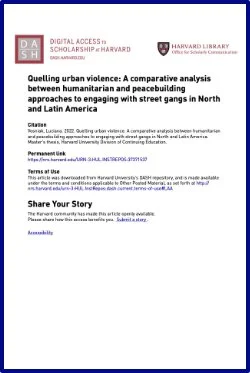Quellling Urban Violence: A comparative analysis between humanitarian and peacebuilding approaches to engaging with street gangs in North and Latin America
By Luciana Vosnick
This research examines and compares how humanitarian and peacebuilding organizations approach engagement with street gangs in North and Latin America for risk management purposes. Drawing from multiple semi-structured interviews with humanitarian and peacebuilding organizations, the study demonstrates that humanitarians and peacebuilders adopt either a risk mitigation or risk prevention approach when engaging with street gangs. Such risk management strategies are informed both by the organizations’ mission and by the normative lenses they adopt when looking at gangs. The research shows that the prevention and mitigation dichotomy responds to a perception of gangs being either a static source of violence to be contained or a social entity capable of change and transformation. Such lenses contribute to creating the framework through which organizations work because they influence how these organizations perceive risk and, as a result, affect how they manage risk on the tactical level.
-
The research results demonstrate that these distinct strategies produce very different outcomes. For instance, a risk mitigation approach produces an apolitical, neutral relationship with gangs that might benefit organizations with a strategic objective centered on delivering immediate, short-term emergency aid. In comparison, a risk prevention approach embodies a more robust engagement with gangs, leading to a higher level of interpersonal trust that might be beneficial for organizations aiming to implement long-term development or violence reduction programs. The research shows that each risk management strategy carries consequences because it affects an organization’s ability to implement programs successfully. The study concludes by offering practical suggestions to charitable organizations seeking to engage with street gangs in violent urban contexts.
Cambridge, MA: Harvard University Division of Continuing Education, 2022. 71p.


